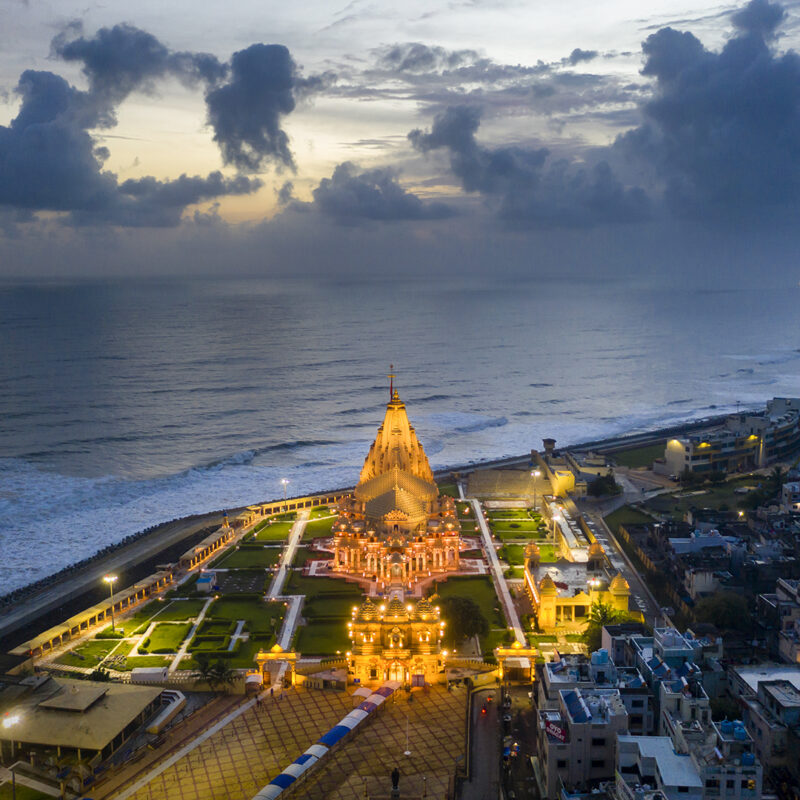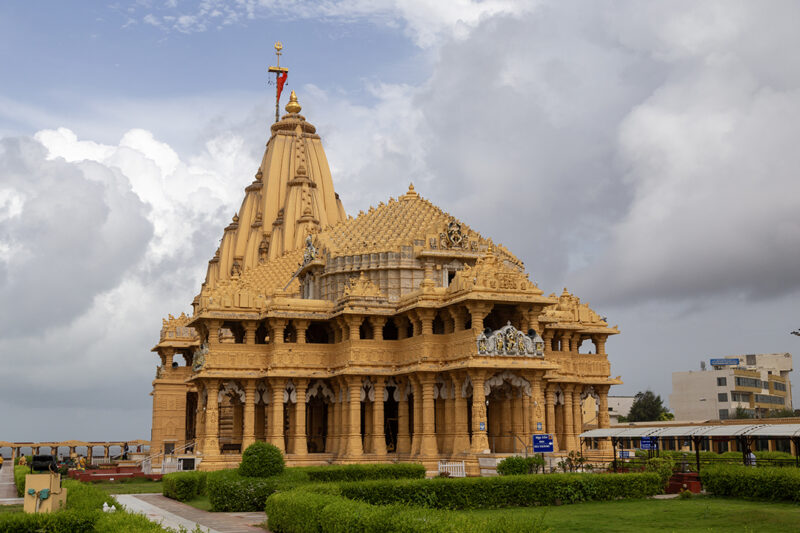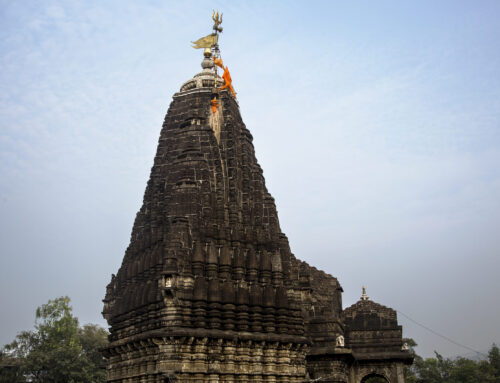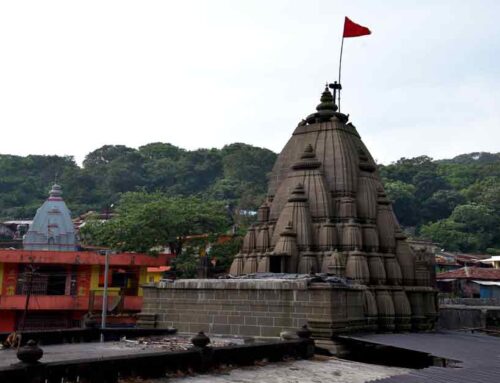One of the twelve Jyotirlinga temples dedicated to Lord Shiva, Somnath Temple is located at Prabhas Patan near Veraval in Gujarat state of India, Somnath Temple is regarded one among the holy temples in Hindu Mythology and History The construction of the temple have been time and again mutilated or reconstructed The present structure was built under the architectural design and sculpture works of Chalukya in 1951
The temple is slightly remote, located near the Arabian Sea and offers a quiet and pious atmosphere; therefore, it attracts both pilgrims and visitors. The prayer ceremony known as Aarti is performed thrice in a day and it is a wonderful attraction. Also, the Sound and Light Show that portrays episodes in the history of the temple is informative and entertaining at the same time. Thus, the Somnath Temple is the embodiment of the Indian people’s spirit and their devotion to their religion and history.
Story of Somnath temple
The Somnath Temple, which is situated in Prabhas Patan in Gujarat, close to Veraval is one Of the twelve Jyotirlingas shrines dedicated To lord Shiva. Descriptive analysis reveals that it has witnessed a turbulent history marked by destructions followed by reconstructions. In legends, this temple was first built by Soma, the Moon God in gold but afterwards rebuilt by Ravana in silver, Krishna in wood and stone by Bhimdev, a Solanki king. This also ends in a temple destruction

Aerial View Of Somnath Jyotirlinga Temple in the evening
Architectural and archaeological significance
Style: The temple is in the Chalukya design that is identified for its rich work done in carvings, sculptures and the use of stone.
Structure: The present construction having undergone several renovations over the years enshrines a very large shikhara which stands at a height of about 50 metres. Its intended style of design and structure is of royal and antique Indian clarity resembling ancient Hindu Temples.
Materials: Mainly built of sandstone, the temple has numerous intricate friezes concentrating on various gods and goddesses, flowers and divine themes and parable motives.
Mandapa and Garbhagriha: The temple includes a big mandapa which is a hall, and sanctum sanctorum or garbhagriha with the sacred Jyotirlinga. Mandapa is prospective and enables many devotees to compile, while the garbhagriha is the most private area, which contains a main deity.
Symbolism: The different architectural features fitted in the temple depict more of Hindus belief system in cosmology and spirituality as a dwelling place of Lord Shiva.
Ancient Origins: The temple stands from prehistoric period and it is mentioned in the Rigveda as well. Notably, while most of the original temples are believed to have been constructed by the Moon God, Soma, the Shiva shrine of Dwarka makes it one of the twelve Jyotirlinga shrines.
General Entry:
Entry Fee: There is no charge for viewing from the outer gallery known as general darshan.
Special Privileges and Services:
VIP Darshan:
Fee: Some amount of fees, generally between INR 50 to 200 is charged for the VIP darshan.
Benefits: Enables devotees to avoid having to wait long hours in queues, keep a closer look of the deity for a relatively longer time.
Aarti Participation:
Fee: There are usually charges for the tickets to attend blessed sessions of aarti which is normally in the range of INR 100 to 500.
Benefits: Affords one the chance to see the rituals in the act and especially in the sanctum zone.
Online Booking:
Service: It shares the services through its official website and application, where one can book for the darshan slots and get special puja services.
Convenience: This has the advantage of organising the visit in advance and not having to wait a long time.
Puja and Rituals:
Fee: It is worthy to note that the charges for puja or ritual differ depending on which ritual is to be performed.
Commonly Performed Poojas and Rates:
- Homatmak Atirudra :- ₹2,700,000
- Homatmak Maharudra :- ₹251,000
- Homatmak Laghurudra :-₹61,000
- Shivpuran Path :- ₹5,500
- Rudrabhishek :- ₹200
- Navgraha Jap 1000 :- ₹250
- Mahamrityunjay Jap 1000 :- ₹250
Accommodation:
Guest Houses: The temple trust runs Bhavathgiris, guest houses and Kar Sevaks Ashram, dormitories for the pilgrims.
Charges: Reasonable charges which are related to the type of accommodation and available facilities.
Special Viewing Areas:
Benefits: However, other places in the vicinity of the temple may be charged; for instance, the Sound and Light Show area.
Experience: Contains historical and mythological information about the temple in audio-visual form.
Important Points:
Dress Code: Certainly, it will be advisable to dress more conservatively; especially women should make sure that their shoulders and knees are not exposed. This is the norm in most of the temples in India which belongs to the Hindus.
Photography: In most of the temples taking pictures of the sacred region is strictly prohibited to adhere to the tradition of the temple.
Timings: The temple is opened in the morning and closes in the evening although there are some timings for aarti as well.
Address: Shree Somnath Trust Prabhas Patan, Near Veraval, Gir Somnath District, Gujarat – 362268, India
Contact Details:
- Phone: +91 2876 231 212
- Email: info@somnath.org
- Website: www.somnath.org
Parking Facilities at Somnath Temple:
General Parking:
– Location: There are designated parking areas near the temple complex for the convenience of visitors.
– Capacity: The parking lots can accommodate a significant number of vehicles, including cars, buses, and two-wheelers.
– Fees: A nominal parking fee may be charged, typically varying based on the type of vehicle. This fee is usually minimal and helps in maintaining the parking facilities.
– Security: The parking areas are generally secure, with attendants and security personnel ensuring the safety of the vehicles.
Donation Facilities at Somnath Temple:
- Donation in the office of the temple premises:
– Location: The temple complex has several donation counters where devotees can make contributions.
– Types of Donations: Devotees can donate cash, cheques, or demand drafts. There are also options for donating specific items such as gold, silver, or other valuables.
- Online Donations
– Website: The temple’s official website provides an option for online donations. Devotees can contribute from anywhere in the world using credit/debit cards or net banking.
– Purpose: Online donations can be made for various purposes, including general maintenance, specific pujas, rituals, and developmental projects undertaken by the temple trust.
Additional Information:
– Receipts: Donors receive receipts for their contributions, which can be used for tax deduction purposes under relevant sections of the Indian Income Tax Act.
– Transparency: The temple trust ensures transparency in the use of donated funds, often providing detailed reports on how the funds are utilized for various developmental and welfare activities.
For the most up-to-date information on parking and donation facilities, it is recommended to visit the official Somnath Temple website or contact the temple administration directly.
How to Reach Somnath Temple:
By Air:
Nearest Airport: The nearest airport is Diu Airport apart from that the alternative airport is rajkot which has better connectivity from places like mumbai and delhi, the next major airpot which is nearest to somnath is Sardar Vallabhbhai Patel International Airport (AMD) in Ahmedabad
By Train:
Nearest Railway Station: The nearest railway station to the temple is Veraval Junction railway station and apart from that there are various railway stations like junagadh and banej .
From Ahmedabad: It is some 400km away, and the trip is roughly seven to eight hours on a car or a bus.
From Rajkot: The distance is approximately 200 km in case one uses transport such as a car or bus it will take 3- 4 hours.
Bus Services:
State Transport Buses: There are many ways to reach Veraval including bus and it lets people know that Gujarat State Road Transport Corporation (GSRTC) runs daily bus service from many cities of Gujarat.
Private Buses: Many Private operators run their buses towards Somnath from other cities such as Ahmedabad, Rajkot, and Mumbai.
Driving Directions:
From Ahmedabad: If by road via car take NH47 to Rajkot keep on NH151 to reach Somnath passing through Junagadh town.
From Rajkot: Catch the NH8B towards Junagarh and then proceed by the NH151 first to Veraval and then to Somnath.
Prasad and special prasad system at somnath temple
The Somnath Temple has a well-organised prasad (offering) system for devotees. Here’s an overview of the prasad system at Somnath Temple:
Types of Prasad:
Dry Prasad:
- Description: Typically includes items like laddoos, dry fruits, and other non-perishable sweets.
- Availability: Available at various counters within the temple complex.
- Packaging: Often packaged in small, convenient boxes or packets for easy distribution and transportation.
Wet Prasad:
- Description: Includes offerings like sweet rice, halwa, and other freshly prepared items.
- Availability: Served during specific times and often needs to be consumed on the same day due to its perishable nature.
Prasad Distribution:
Free Distribution:
- Daily Distribution: Prasad is distributed free of cost to all devotees after certain rituals and ceremonies, especially after the main aarti (prayer) sessions.
- Timings: Distribution usually coincides with the conclusion of major aarti sessions, which are held multiple times a day.
Purchase Options:
- Prasad Counters: Dedicated counters within the temple complex where devotees can purchase prasad for themselves and as offerings to be taken home.
- Price Range: Prices are nominal, making it affordable for all devotees to take home a piece of the divine blessing.
Special Prasad Offerings:
1.Annadanam (Food Donation):
- Description: The temple trust runs an Annadanam scheme where free meals are provided to devotees and the needy.
- Participation: Devotees can contribute to this scheme by making donations, which helps in the preparation and distribution of these meals.
- Timings: Typically, meals are served at designated times, such as lunch and dinner.
2.Special Puja Prasad:
- Description: Devotees who participate in special pujas and rituals can receive prasad as part of the offerings.
- Booking: These can be pre-booked through the temple’s official website or at the temple counters.
Annual Events at Somnath Temple
1.Maha Shivaratri
Date: Celebrated annually in the month of Phalguna (February/March).
2.Somnath Fair (Kartika Purnima)
Date: Occurs in November.
Monthly Events at Somnath Temple
Amavasya (New Moon Day)-
Purnima (Full Moon Day-
Ekadashi-
FAQs for a Fulfilling Journey to Somnath Temple
Q: What are the temple timings?
A: Somnath Temple is open from 6:00 AM to 9:30 PM, with three aartis at 7: 00 AM, 12:00 PM, and 7:00 PM.
Q:What is the best time to visit?
A: The ideal time to visit is from October to March due to pleasant weather.
Q: Are there any dress code requirements?
A: Yes, modest attire is recommended; avoid shorts and sleeveless tops.
Q: How can I reach Somnath Temple?
A: The nearest airport is Diu (85 km), and the closest railway station is Veraval (7 km). Buses and taxis are readily available.
Q: Are accommodation facilities available nearby?
A: Yes, there are several hotels, guesthouses, and dharamshalas near the temple.
Q: Is photography allowed inside the temple?
A: No, photography is strictly prohibited within the temple premises.
Q: What are some nearby attractions?
A: Nearby attractions include Bhalka Tirth, Triveni Sangam, and the Somnath Beach.
Q: Are there any special events to look out for?
A: Major events include Maha Shivaratri and the Somnath Fair during Kartika Purnima.
Nearby Attractions to Somnath Temple
Thus this was some of the most important information that visitors should checkout before visiting the somnath temple.
|| Jai Somnath ||



